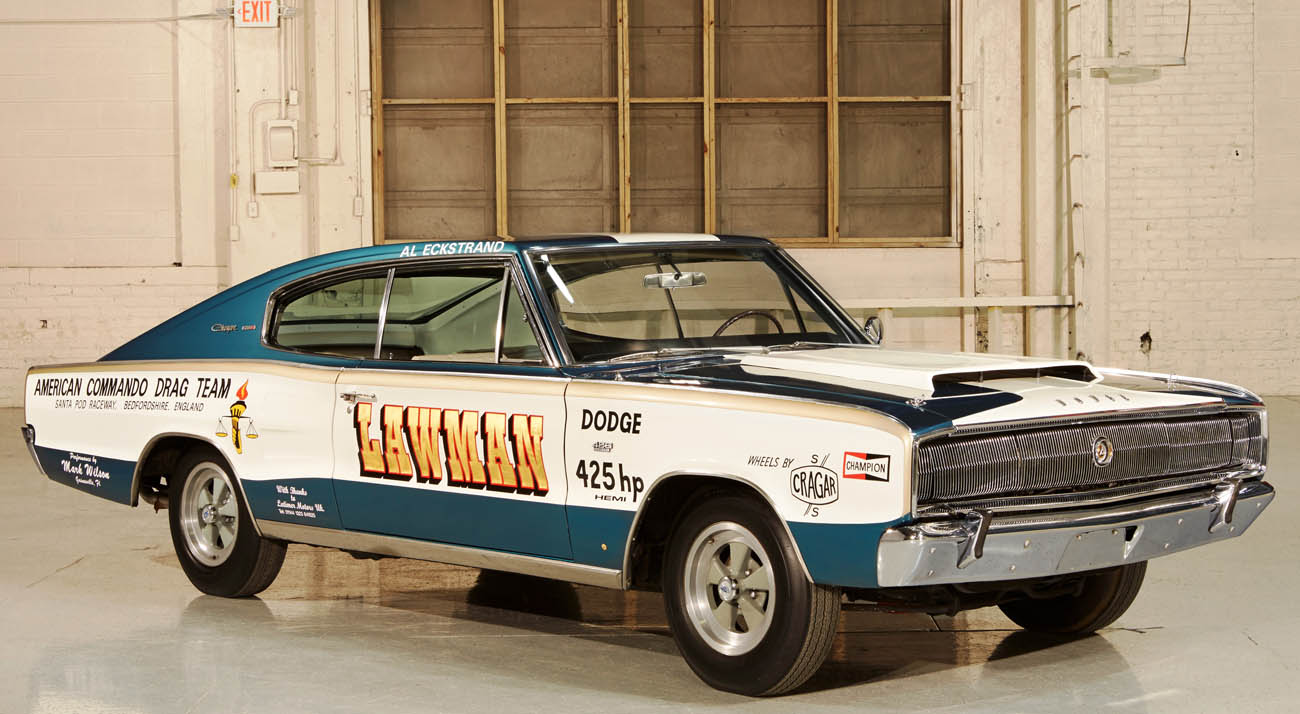
The Dodge Charger is an American icon. From its muscle-car performance roots, legendary styling and racing heritage, to its modern-day performance with world-class engineering and technology — the Dodge Charger has, and continues to be, one of the most competitive performance cars both on and off the track. And with the best powertrains in the business, including the fearsome “Elephant Motor” — the 426 HEMI® and the modern 6.4-liter HEMI, Dodge Charger continues to add to one of the most storied nameplates in automotive history.
The Dodge Charger was introduced on Jan. 1, 1966. Built off of the Dodge Coronet chassis but using its own body, the new Charger was the Dodge brand’s first production fastback, high-speed street racer. It featured many styling cues from the Charger II concept car, like a fastback roof design and full-width tail lamps. The interior featured four bucket seats and a full-length center console.

Carl “CAM'” Cameron would be the exterior designer of Dodge’s new flagship vehicle, and on January 1, 1966, viewers of the Rose Bowl were first introduced to the new “Leader of the Dodge Rebellion”, the 1966 Charger. The Charger’s introduction coincided with the introduction of the new street version of the 426 Hemi. Finally, Dodge would have the performance image to go along with this performance engine.
As the 1966 Charger’s features would go, the “electric shaver” grille used fully rotating headlights that when opened or closed made the grille look like one-piece. Inside, the Charger used four individual bucket seats with a full length console from front to rear. The rear seats and console pad also folded forward, and the trunk divider dropped back, which allowed for lots of cargo room inside. Many other things were exclusive to the Charger such as the door panels, courtesy lights and the instrument panel.

The instrument panel was especially interesting as regular bulbs weren’t used to light the gauges. Instead four electroluminescent dash pods housed the tachometer, speedometer, alternator, fuel and tempature gauges. In the rear the full length taillight read CHARGER.
The engine selection was all V8s. A six cylinder engine didn’t make the option list until 1968. In 1966 four engines were offered; the base-model 318 in³ 2-barrel V8, the truck-sourced 361 in³ 2-barrel, the 383 4-barrel, and the new 426 Street Hemi. The majority of 1966 Chargers were ordered with the 325-hp 383.

Total production in 1966 came to 37,344 units, which was successful for the mid-year introduction.
The first-generation Dodge Charger came with a standard 318 cubic-inch V-8 engine that delivered 230 horsepower. Other available engines included a 361 cubic-inch V-8 engine, which delivered 265 horsepower or a 383 cubic-inch V-8 engine that delivered 325 horsepower. However, it was the availability of the massive 426 cubic-inch “Street” HEMI V-8 engine that provided 425 horsepower and 490 lb.-ft. of torque that forever defined Dodge Charger as a performance car.
The HEMI V-8 engine was already a legend in the mid-1960s as Chrysler Corporation cars dominated NASCAR. However, in 1965 NASCAR banned the HEMI engine, as it did not follow the new guidelines mandating that engines had to be available for serial production. The company boycotted the racing season.

Minor updates were added to the Dodge Charger in 1967, including the addition of small front fender turn indicators and a vinyl roof option. Underneath the crisp two-door styling, a collapsible steering column and dual-system master cylinder became standard equipment to meet the arrival of U.S. Federal Safety regulations.
From the marketing perspective, the Dodge brand abandoned its “Join the Rebellion” theme and moved forward with a performance-oriented “Road & Track” theme.

Source: Dodge & Wikipedia (under the GNU Free Documentation License)



